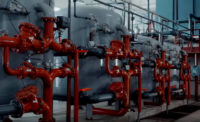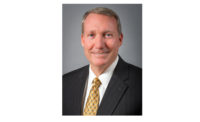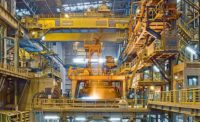Industrial fittings trends
Trends respondents optimistic for the most part on what 2019 could bring.

OK Pipe & Fittings Owner and President Gabe Hatfield sees growth in the fittings market. “The focus on domestic supply and the import tariffs on steel will help support U.S. growth in the fittings market,” he says. Photo by Krystal Hatfield.
The topic of tariffs that have affected the industrial PVF supply chain still remains front and center, according to fittings manufacturers.
Throw in trade-cases rulings and the ups and downs of oil prices while you are at it, says Steve Romanelli, president and COO of Carol Stream, Illinois-based industrial fittings manufacturer Core Pipe. “These days, buyers are making quicker decisions on product buys rather than wait for the unknown penalties in the future. Not knowing what the future trends will be for oil pricing and tariffs may cause some delays for projects as customers weigh the risks against their return.”
Joe Pro, president of fittings manufacturer Penn Machine, points to the anti-dumping and counterveiling suits brought by fellow manufacturer Bonney Forge as a prime example. “The impact of the suits brought by Bonney Forge has led to shortages of imported forged steel fittings in the U.S.,” he says. “As uncertainty over imported sources grew, many PVF distributors increased their domestic purchases to supplement their imported inventories.”
Pro says his company has seen increased business due to that reduction in imported forged steel . “I don’t think the increase will be sustainable for a long period of time,” he says. “History has shown us that the import market will begin moving production to new countries not impacted by the dumping suits. The cycle will begin all over again.”
Gabe Hatfield, owner and president of Moscow, Texas-based OK Pipe & Fittings, says the steel tariffs have increased the cost of pipe his company uses for making items such as laterals and mitered elbows, tees and crosses. “We have been able to mitigate this because we produce everything in-house domestically,” he says.
Legend Director of Marketing Wade Tennant says another key trend in the industrial space is the growth in the coal and shale-oil markets. “When hose houses are growing so is the valve market,” he says.
Tennant notes other items Legend is keeping a close watch on are the lack of skilled labor, not enough investment in vocational/technology schools for the future of the industry, the increased price pressures from inflation as well as increases in raw materials, concerns over international trade policy (tariffs) and concerns if the shale oil markets slow.
Despite these swirling winds in the industry, fittings manufacturers who participated in this trends inquiry report more strong growth. “2018 was a strong year,” Tennant says. “We see the market in 2019 to be very similar to 2018 with a flat to slightly up trajectory and another strong year for housing starts.”
Hatfield has noticed an increase in municipal water-utility projects and new plants, which seem to be carrying over into this year, he explains. “The market volume did level off after a two-year increase, which is primarily due to the recent election and the change in power in the House,” he says. “It will probably start off better after the new year, but increase at a slower rate than 2017 and 2018. The focus on domestic supply and the import tariffs on steel will help support U.S. growth in the fittings market, along with the emphasis on infrastructure and jobs.”
Penn Machine’s Pro also reports a strong 2018 for the Pennsylvania-based manufacturer. “We have seen increased demand before and after the reduction in imported forged steel,” he says. “I think 2019 will be flat when compared to 2018. Many larger distributors are flush with material and will probably begin working off that inventory during the first quarter here in 2019. If project demand remains steady and we get clarity on trade status and tariffs, 2019 will be good. The U.S. has become the energy juggernaut with oil and gas production. Getting these products to market through pipelines is the next big hurdle.”
Core Pipe’s Romanelli sees more prosperity in the offing for this year. “2018 was an improvement over 2017 and there has been some stability in the market as a result of trade actions that are finally being realized to the benefit of U.S. manufacturers,” he says. “2019 should continue to be a stronger year and there is hope that some agreement on an infrastructure plan for the nation can spur additional growth for much-needed projects.”
Looking for a reprint of this article?
From high-res PDFs to custom plaques, order your copy today!









